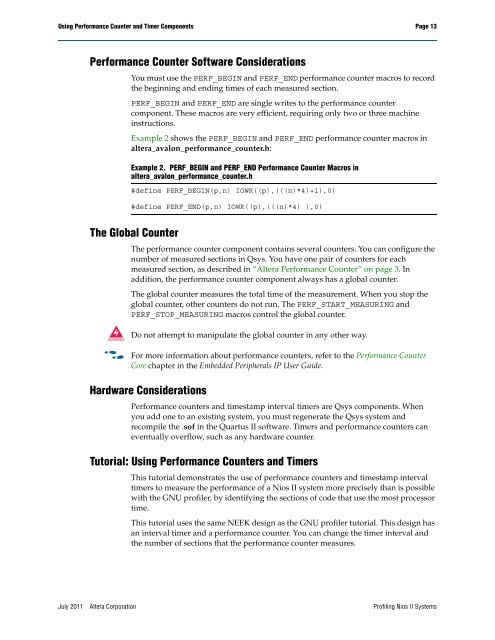Profiling Nios II Systems Application Note 391 - Altera
Profiling Nios II Systems Application Note 391 - Altera
Profiling Nios II Systems Application Note 391 - Altera
You also want an ePaper? Increase the reach of your titles
YUMPU automatically turns print PDFs into web optimized ePapers that Google loves.
Using Performance Counter and Timer Components Page 13<br />
Performance Counter Software Considerations<br />
You must use the PERF_BEGIN and PERF_END performance counter macros to record<br />
the beginning and ending times of each measured section.<br />
PERF_BEGIN and PERF_END are single writes to the performance counter<br />
component. These macros are very efficient, requiring only two or three machine<br />
instructions.<br />
Example 2 shows the PERF_BEGIN and PERF_END performance counter macros in<br />
altera_avalon_performance_counter.h:<br />
Example 2. PERF_BEGIN and PERF_END Performance Counter Macros in<br />
altera_avalon_performance_counter.h<br />
#define PERF_BEGIN(p,n) IOWR((p),(((n)*4)+1),0)<br />
#define PERF_END(p,n) IOWR((p),(((n)*4) ),0)<br />
The Global Counter<br />
The performance counter component contains several counters. You can configure the<br />
number of measured sections in Qsys. You have one pair of counters for each<br />
measured section, as described in “<strong>Altera</strong> Performance Counter” on page 3. In<br />
addition, the performance counter component always has a global counter.<br />
The global counter measures the total time of the measurement. When you stop the<br />
global counter, other counters do not run. The PERF_START_MEASURING and<br />
PERF_STOP_MEASURING macros control the global counter.<br />
w Do not attempt to manipulate the global counter in any other way.<br />
f For more information about performance counters, refer to the Performance Counter<br />
Core chapter in the Embedded Peripherals IP User Guide.<br />
Hardware Considerations<br />
Performance counters and timestamp interval timers are Qsys components. When<br />
you add one to an existing system, you must regenerate the Qsys system and<br />
recompile the .sof in the Quartus <strong>II</strong> software. Timers and performance counters can<br />
eventually overflow, such as any hardware counter.<br />
Tutorial: Using Performance Counters and Timers<br />
This tutorial demonstrates the use of performance counters and timestamp interval<br />
timers to measure the performance of a <strong>Nios</strong> <strong>II</strong> system more precisely than is possible<br />
with the GNU profiler, by identifying the sections of code that use the most processor<br />
time.<br />
This tutorial uses the same NEEK design as the GNU profiler tutorial. This design has<br />
an interval timer and a performance counter. You can change the timer interval and<br />
the number of sections that the performance counter measures.<br />
July 2011 <strong>Altera</strong> Corporation <strong>Profiling</strong> <strong>Nios</strong> <strong>II</strong> <strong>Systems</strong>
















